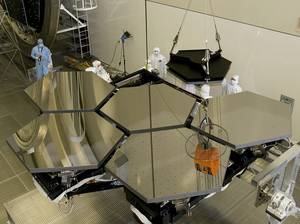Big news for Extremely Large Telescope
Interview with
The University of Oxford have announced their role i the European Extremely Large  Telescope and it's going to be big. Andrew Pontzen from the University College London gave an update to Kat Arney...
Telescope and it's going to be big. Andrew Pontzen from the University College London gave an update to Kat Arney...
Andrew - It's slated to be ready and take its first observations in 2024 so it's still some way off. But the thing about this telescope is it's going to be almost 40 meters across. So, it's a 40-meter digital camera if you like, to look at the night sky. Just to give you some sense of just how big that is, it's going to be assembled out of lots of sort of small mirrors that focus the light. 800 of these small mirrors and each of those 800 small mirrors is sort of the size of a person. So, you assemble all of those together and you have this huge collecting area to collect light coming at you from space. It means we're going to be able to see extremely faint objects and get a lot more detail than we could before. The news that's come this week is that the latest instrument that's going to sit on the end of this camera and actually take the observations, take all that light and turn them into something we can use has just been commissioned. It's just been signed off - something called the HARMONI spectrograph and it's really going to put that huge collecting area for light to best use because it's not just going to take pictures. It's not like a digital camera that just takes some coloured pictures.
Kat - I'm assuming it's better than an iPhone or similar for camera phone.
Andrew - Even better than an iPhone.
Kat - Other camera phones are available.
Andrew - Your camera images are made out of individual pixels, individual dots which are coloured. Every single one of those, it's going to take what we call a spectrum. It's basically going to break the light down into all of the different wavelengths or colours that you can possibly separate it out into.
Kat - Is that across the whole of the electromagnetic spectrum or still just a kind of a chunk of that?
Andrew - Well, it's the chunk of that because it's going to be built in Chile which is quite high up, but there's still atmosphere that the light has to come through. That means a lot of it is filtered out. So, it's just the chunk that you can actually get at which is the visible light that you and I can see, plus some infrared light. But it's going to break it down into that spectrum and that means every single dot of say, galaxy that you've taken a picture of, you're going to get detailed exquisite information about everything that's going on in that tiny little dot.
Kat - So, we're going to get some really awesome pictures. Is it that kind of telescope? We're going to see these amazing things.
Andrew - You certainly are going to see incredible images, but you'll also going to be able to boil it down into data. That's what we really care about in astronomy now, it's data. And so, for example, in one shot, you could get a beautiful image of a galaxy but you could also tell exactly how that galaxy is rotating. In the past, that's something that we've needed to do with separate instruments. You would need to take one picture to have a look at what it looks like and then apply a completely different instrument to get a spectrum. So now, you can do all of it at once, get all of this very faint light, collect it altogether, and it's just going to be so exciting. But it is nine years away.
Kat - And is it the biggest telescope? Is it going to be the biggest in the world?
Andrew - It certainly is. The Americans are trying to compete but they're not quite going to get there because they're building a 30-meter telescope. This one will be very nearly 40 meters across.
- Previous Concussions at the Rugby World Cup
- Next The road to recovery










Comments
Add a comment